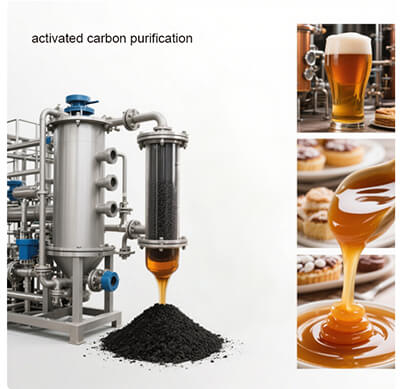Maltose, often called malt sugar, is a versatile disaccharide playing a key role in everything from brewing beer and baking bread to formulating candies and pharmaceuticals. Produced primarily through the enzymatic hydrolysis of starch, the resulting maltose syrup often contains various impurities that can affect its color, taste, stability, and suitability for specific applications. So during the production, activated carbon has been regarded as the most suitable material to purify and decolorize..jpg)
What is Maltose?
Briefly, maltose (C₁₂H₂₂O₁₁) is made of two glucose units linked together. It's less sweet than sucrose (table sugar) and fructose but provides body, texture, and fermentable sugars crucial in many food and beverage processes. Common sources include barley (malting process), corn syrup, and other starches.
What is Activated Carbon (AC)?
Activated carbon isn't your typical charcoal briquette. It's carbonaceous material (like coconut shells, wood, or coal) that has been processed (activated) at very high temperatures, often with steam or chemicals. This process riddles the carbon with millions of tiny pores, dramatically increasing its internal surface area – a single gram can have the surface area of a football field! This vast surface area is key to its superpower: adsorption. Adsorption is the process where molecules adhere to the surface of a solid (the adsorbent, in this case, AC).
Why Purify Maltose Syrup?
Crude maltose syrup, fresh from starch hydrolysis, isn't usually ready for prime time. It often contains:
• Color Bodies: Compounds formed during processing (like melanoidins from Maillard reactions) that give the syrup an undesirable yellow or brown tint.• HMF (Hydroxymethylfurfural): A compound formed from sugars under acidic and heated conditions, sometimes considered undesirable in high concentrations.
• Proteins and Amino Acids: Residuals from the original starch source.
• Off-Flavor and Odor Compounds: Volatile substances impacting the sensory profile.
• Salts and Minerals: Depending on the process water and raw materials.
These impurities can negatively impact the final product's appearance, taste, shelf life, and performance in downstream applications (e.g., crystallization, fermentation).
How does Activated Carbon Purify Maltose?
Activated carbon is a workhorse in sugar and syrup purification, including maltose. Here’s how it helps:
Decolorization: This is perhaps the most common application. The larger organic molecules responsible for color are readily adsorbed onto the vast surface area of the activated carbon. The AC selectively traps these color bodies while allowing the smaller maltose molecules to pass through relatively unaffected.Removal of HMF: Certain grades of activated carbon are effective at adsorbing HMF and related furanic compounds.
Taste and Odor Improvement: Activated carbon effectively adsorbs many volatile organic compounds that cause undesirable flavors and odors, leading to a cleaner-tasting maltose syrup.
Removal of Other Organic Impurities: Depending on the pore size distribution of the AC, it can also adsorb residual proteins or other large organic molecules.
Which type of activated carbon is suitable for Maltose?
There are two main ways activated carbon is used:
Powdered Activated Carbon (PAC): Fine AC powder is mixed directly into the maltose syrup for a specific contact time. Afterward, the spent carbon (now loaded with impurities) is filtered out, leaving behind a purified syrup. This is common for batch processing.Granular Activated Carbon (GAC): Larger AC granules are packed into columns. The maltose syrup flows through these columns, and impurities are adsorbed as it passes. GAC systems are often used for continuous processing and have the advantage that the carbon can sometimes be regenerated (cleaned and reused), although this can be complex for food-grade applications.
For maltose purification, selecting an AC grade optimized for adsorbing the specific color bodies and other target impurities present in the syrup is crucial for efficiency and minimizing maltose loss. Food-grade certification is, of course, essential.
Conclusion
Activated carbon plays a vital, albeit often unseen, role in delivering the high-purity maltose syrups demanded by modern food, beverage, and pharmaceutical industries. Through the simple yet powerful principle of adsorption, it effectively removes unwanted color, flavors, odors, and other impurities. This purification step ensures that maltose can perform its intended function perfectly, whether contributing to the golden hue of a lager, the soft texture of baked goods, or the precise formulation of a medicine. testament to how a carefully engineered material can refine nature's sweetness.

